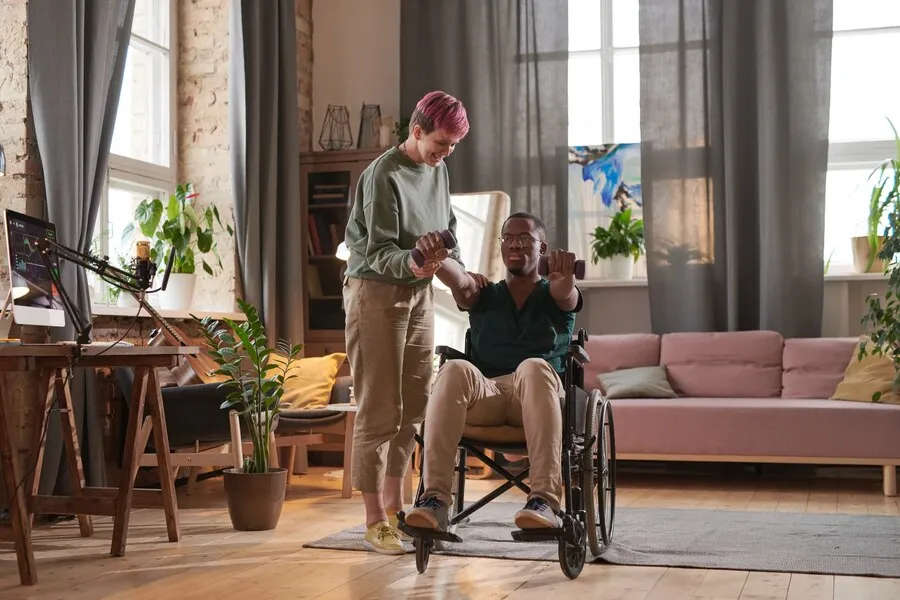Making your home more accessible and comfortable for individuals with disabilities enhances mobility and improves quality of life. This means being mindful of accessibility when designing and modifying your living spaces. Here are 10 must-know tips to help you transform your home into a disability-friendly living space.
1. Widen Doorways
For individuals who use wheelchairs or other mobility aids, widening doorways is crucial for easy movement throughout the house. The standard doorway width is usually around 32-36 inches, but for wheelchair users, a minimum of 42 inches is recommended. This allows for easier navigation and maneuvering without any obstructions.
2. Install Ramps
Ramps are essential for individuals who use wheelchairs or walkers to enter and exit the house safely. They provide a smooth and gradual incline instead of stairs, making it easier for individuals with mobility impairments to navigate. Ramps should have a gentle slope and be wide enough for the wheelchair or walker to fit comfortably.
3. Lower Countertops
In the kitchen, lower countertops allow individuals who use wheelchairs to easily access and prepare food. Installing pull-out shelves and drawers can also make items more reachable for those with limited mobility. Lowering countertops in the bathroom can also make it easier for individuals to use the sink and mirror.
4. Add Grab Bars
Grab bars are essential safety features that provide support and stability for individuals with disabilities. They should be installed near toilets, bathtubs, and showers to assist with balance and prevent falls. Make sure to choose grab bars that can support a person’s weight and are properly installed.
5. Consider Flooring
When it comes to flooring, smooth and slip-resistant surfaces are ideal for individuals with disabilities. Carpets can be difficult to navigate for wheelchair users, so hardwood or laminate floors with non-slip rugs are a better option. If using carpet, choose a low pile or loop style for easier movement.
6. Leverage Smart Technology
Smart technology can greatly improve accessibility and convenience for individuals with disabilities. Voice-activated devices, motion sensors, and smart home systems can allow individuals to control various aspects of their living space without physical exertion. For example, door locks with wifi can offer enhanced security and ease of access, allowing doors to be locked or unlocked remotely via a smartphone app. This technology is particularly useful for individuals with physical limitations, as it eliminates the need for manual operation of locks.
7. Consider Lighting
Proper lighting is essential for a disability-friendly living space. Adequate lighting helps individuals with vision impairments navigate the house safely. Consider installing motion-activated lights in hallways and staircases to avoid fumbling for light switches. Additionally, using color contrast is helpful for those with low vision, such as using dark-colored light switches against lighter walls.
8. Invest in Chairlifts or Stairlifts
For individuals with mobility impairments who live in multi-level homes, chairlifts or stairlifts can greatly improve accessibility. These devices allow individuals to easily and safely move between floors without assistance. Chairlifts are motorized seats that travel along a track attached to stairs, while stairlifts are similar but attach directly to the wall. Both options can be customized to fit the specific needs of the individual and their home.
9. Consider Handicap-Accessible Vehicles
In addition to modifying your home, it may also be necessary to modify vehicles for individuals with disabilities. This could involve installing wheelchair lifts, hand controls for driving, or other adaptations depending on the individual’s needs. Many companies specialize in making vehicles accessible for individuals with disabilities.
Also Read: Home Sweet Home: Creating a Pest-Free Environment
10. Consult with Professionals
Lastly, it is important to consult with professionals such as occupational therapists or accessibility consultants when modifying your home for disability-friendly living. They can provide expert advice and recommendations tailored to the specific needs of the individual and their home. They can also assist with obtaining any necessary permits or approvals for modifications.
By following these 10 must-know tips, you can create a safe, comfortable, and accessible living space for individuals with disabilities. Remember to always prioritize the individual’s needs and consult with professionals when needed. With some modifications and adjustments, it is possible to transform your home into a disability-friendly oasis. So, don’t hesitate to take action and make your home more accessible for yourself or your loved ones today!

